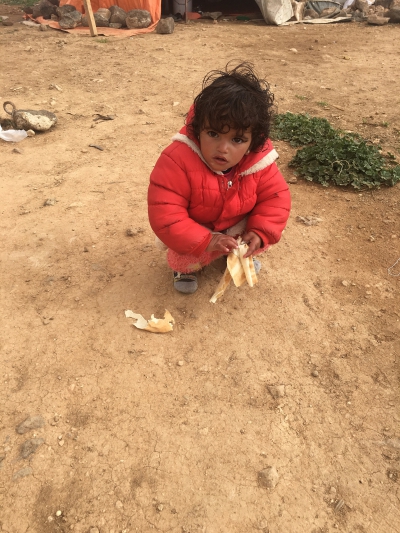IMANA VOLUNTEER STORIES
Journaling Helps SaveSyria Volunteer Process Her Experience: A Blog Entry by Dr. Nabila Choudhury
Dr. Nabila Choudhury
March 18th, 2019
Its 4 am in Jordan. My mind is racing, with so many thoughts about our experiences today. While we’ve had many memorable experiences during the past week, I think my team members and I can all agree that today was a special day. This morning, the team traveled from Amman to Al Mafraq, a city tucked away along the northeast border of Jordan. Mafraq contains a large population of urban refugees living in the barest of conditions — organized communities with hundreds of tent houses. A short distance ahead, past the barren land and sprinkle of tents, the Syrian border was clearly visible.

Photo Credits: Dr. Nabila Choudhury
As we disembarked, one of our translators, a Syrian refugee herself, was clearly impacted by our proximity to the border. She had not been this close to Syria since her family fled from the war. But in moments such as these, there is very little time to pause and reflect on these matters – there is work to be done; the clinic has to be set up as there are patients already waiting.
We created our clinic and exam rooms within the tents of three refugee families who volunteered their homes. The bus we arrived in became our pharmacy where medications were dispensed to lines of waiting patients. As these families welcomed us into their homes — houses made of tarps and anchored by rocks — these families essentially facilitated and made our medical efforts possible.

Photo Credits: Dr. Nabila Choudhury
We had the opportunity to not only treat these refugees, but to sit in their homes, play with their children, and walk amongst them into nearby villages — this was an experience unlike any other. My colleagues and I saw a variety of patients: from the elderly to newborns, from pregnant patients to postpartum. We addressed acute issues, such as postsurgical wounds, to chronic ailments. There was no deficiency in the multitude of diverse cases we experienced. Additionally, several of my colleagues trekked to neighboring villages to make home visits to patients who could not travel to our clinic site due to their limitations.
The realities of this refugee crisis, highlight two extremes — both the depths of human suffering, but also the incredible resiliency of these refugees. And this notion was vividly apparent as we spent the day in Mafraq. These refugees seemed to be the hardest hit by the Syrian war and the least recovered. They lived in open-air tents, sharing communal structures with limited resources. And yet, they opened their homes to strangers, offered us food and drink from their limited supplies, and helped bring neighboring refugees to the clinic so they, too, could obtain care.
Today’s experience clearly resonates the notion that humanity’s struggle to maintain hope during these difficult situations will be fought not just by the volunteers and health care providers who embark on relief efforts, but our patients — these refugees — who struggle to not only improve their lives, but the lives of one another.

Photo Credits: Dr. Nabila Choudhury

Photo Credits: Dr. Nabila Choudhury (third from left)

Photo Credits: Dr. Nabila Choudhury (third from left)
Upon the conclusion of the mission, Dr. Choudhury reflected further on the experience:
I don’t think any of us were ready for this trip to end — it was such a surreal experience. Amongst one another, we all spoke about our last patients — as though these stories were anchors to keep us in this experience for just a little bit longer. The relationships we forged with the UMR staff, the translators and the clinic volunteers have been rewarding and fulfilling. I am in awe of the tireless dedication and effort of these individuals towards the refugees that live within Jordan.
SUPPORT IMANA MEDICAL RELIEF MISSIONS: imana.org/donate